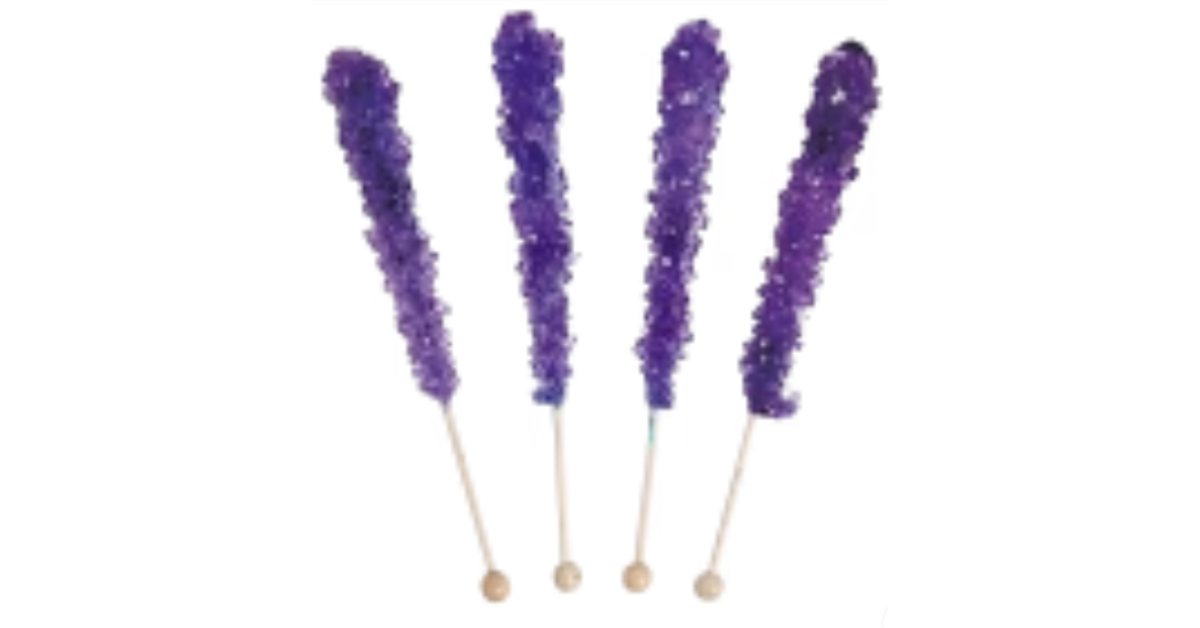Rock candy isn't just a colorful treat from your childhood. It's a crystalized form of sugar that still holds strong in America’s snack scene. With its vibrant colors, satisfying crunch, and sweet flavor, it continues to charm people of all ages. Whether used for decorating cakes, sweetening tea, or satisfying a sugar craving, rock candy has earned its place on the shelf and in our hearts.
Let’s explore the fascinating story, uses, and surprising benefits of rock candy.
What Is Rock Candy?
Rock candy is crystallized sugar that forms by allowing a supersaturated sugar solution to cool over several days. As water evaporates, sugar crystals grow into large, transparent chunks. It’s one of the purest forms of sugar, and it dates back over 1,000 years.
In the U.S., rock candy is mostly made from refined white sugar and natural or artificial flavors. It’s available on wooden sticks, strings, or loose crystals. Its color depends on the food coloring used during preparation.
How Is Rock Candy Made?
Making rock candy is a simple process that involves a few ingredients:
- Granulated sugar
- Water
- A heat source
- A container
- A string or stick for crystals to form on
Here’s a quick step-by-step breakdown:
- Boil water and dissolve sugar until no more will dissolve (saturation point).
- Add color or flavor if desired.
- Pour the solution into jars.
- Suspend a string or stick inside.
- Let it sit undisturbed for 5–7 days.
As the solution cools and evaporates, sugar sticks to the string and forms beautiful crystals.
Top 5 Uses for Rock Candy
Rock candy is more than a sweet snack. It’s also functional in other areas:
- Tea sweetener: In Asia and Europe, it’s often used to sweeten hot beverages.
- Decorative desserts: Add sparkle to cupcakes, cakes, and candy tables.
- Cocktail garnish: Bartenders use it for an eye-catching touch.
- Kids' science projects: Great for teaching about crystallization.
- Home remedies: Some cultures use it to soothe sore throats.
Is Rock Candy Healthy?
While rock candy is high in sugar, it’s cleaner than many processed candies. It contains no additives or preservatives if homemade. In moderation, it’s not harmful, but eating too much can lead to weight gain and dental issues.
Did you know?
The average American consumes 17 teaspoons of added sugar per day—more than double the recommended amount.
Fun Facts About Rock Candy
- Rock candy dates back to the 9th century in Iran.
- In the 1800s, it was sold in American apothecaries as medicine.
- Blue raspberry and cherry are the top-selling flavors in the U.S.
- Rock candy crystals can grow up to 2 inches wide if undisturbed.
- More than 60% of U.S. candy stores still sell rock candy in some form.
Different Types of Rock Candy
In the U.S., you’ll find rock candy in several styles:
- Stick rock candy – Crystals grow on wooden sticks for easy snacking.
- String rock candy – Crystals grow on a thread, often used in recipes.
- Loose crystal rock candy – Sold in jars or bags for topping desserts.
- Flavored rock candy – Infused with lemon, cinnamon, mint, or fruit flavors.
- Colorless rock candy – Often used in cooking or drinks for a neutral taste.
Why Is Rock Candy Still Popular in the U.S.?
According to a 2023 market report, the U.S. candy industry is worth over $40 billion annually. Nostalgic candies like rock candy have seen a 15% rise in sales since 2021.
“People crave simple, traditional sweets they grew up with,” says Jake Sanders, VP of American Candy Alliance.
It’s also a big hit in gift shops, state fairs, weddings, and holiday events. Its visual appeal makes it a hit across all ages.
How to Store Rock Candy
Proper storage keeps rock candy fresh for months. Here's how:
- Store in an airtight container
- Keep away from moisture
- Avoid direct sunlight
- Do not refrigerate
Unopened, it can last up to 12 months. Once opened, consume within 3–6 months.
Can You Make Rock Candy at Home?
Absolutely! In fact, homemade rock candy is a fun activity for kids and adults.
Tips for the best homemade rock candy:
- Use distilled water for better crystal clarity.
- Let the solution cool slightly before adding the stick.
- Keep the jar covered with a paper towel to reduce dust.
- Don’t move the container once the crystals start forming.
Top Rock Candy Brands in the U.S.
- Dryden & Palmer
- Espeez
- The Rock Candy Shoppe
- Squire Boone Village
- Hammond’s Candies
These brands offer assorted colors, flavors, and sizes, with nationwide delivery options.
Where to Buy Rock Candy in the U.S.
You can find rock candy in:
- Candy stores
- Party supply stores
- Online retailers like Amazon, Walmart, and Etsy
- Some supermarkets and drugstores
Prices range from $5 to $15 depending on size and packaging.
Is Rock Candy Vegan and Gluten-Free?
Yes, pure rock candy is naturally gluten-free and vegan. It contains no animal products, wheat, or gluten. However, always check labels for added colors or flavors that may include animal byproducts.
Interesting Quote
"Rock candy brings back memories of simpler times. Its appeal lies in its purity." — Linda Crawford, Candy Historian, National Confectioners Association
Final Thoughts
Rock candy continues to be a timeless treat in American culture. With its visual charm, sweet crunch, and versatile uses, it stands out from modern snacks. Whether you're enjoying it on a stick, stirring it in your tea, or using it as cake decor, it never goes out of style.





Comments